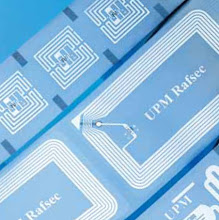With fully printable tags still years away, companies are designing methods of manufacturing RFID-enabled packaging that will work today.
March 13, 2007—For years, RFID evangelists have described how RFID tags will one day be printed directly onto or into packaging materials used for consumer goods. Last year, Texas Instruments (TI) and packaging firm Smurfit-Stone demonstrated a prototype RFID-enabled cardboard box that the companies created by printing an RFID antenna on its inner layer of paperboard, then attaching a strap, or small metal die housing an RFID chip, onto the antenna (see TI, Smurfit-Stone Demo RFID-Enabled Cases).
But neither Smurfit-Stone, nor any other large cardboard manufacturer, has yet to bring a system such as this to production—and that, say some RFID technologists, is because the process is too disruptive to current corrugate-manufacturing processes, not to mention expensive. Two separate groups—one involving conductive ink and adhesive manufacturer Parelec and RFID tag maker Tagsys, the other consisting of Taiwanese RFID technology startup Yeon Technologies and Yuen Foong Yu Paper—have developed what they consider more-appealing alternatives.
Parelec and Tagsys say they have developed a means of RFID-enabling packaging that is less disruptive than printing an antenna and attaching a chip or chip-on-strap assembly to the antenna, to form an inlay. In addition, they claim, it is less costly to deploy. Yeon Technologies says it has also developed a means of RFID-enabling packaging material without significantly impacting its manufacturing process.
The process developed by Parelec and Tagsys, according to Parelec president Geva Barash, consists of printing an antenna directly onto a paperboard layer of corrugate packaging material using Parelec's Parmod VLT conductive ink. The packaging material, consisting of alternate layers of paperboard and corrugate, is used to construct a typical cardboard box. The ink is comprised of metal particles in a reactive organic medium that volatize during the heating process. Instead of adhering an RFID chip or chip-on-strap assembly directly to the antenna, the companies have devised a means of attaching a small but complete RFID inlay: the Tagsys Adaptive Kernel inlay.
This process, says Barash, will help packaging manufacturers minimize the impact on their current production processes—not only because printing the antenna can be done as an inline process without diverting the cardboard from existing printing lines, but also because adhering the Tagsys inlay to the antenna can be incorporated into existing label-attach processes.
"By placing [the Kernel inlay] on the printed antenna," Barash says, "you don't need to be as precise with your placement as you do with adding a chip or strap to an antenna, which requires an accuracy in the range of 0.2 microns."
The Kernel inlay is about 1 inch square, Barash explains, and when attached, via conductive adhesive, to the printed antenna on the outside of a cardboard box, the resulting inlay-antenna tag can be read from up to 23 feet away. The companies have prototype boxes they've demonstrated at recent conferences.
According to Barash, Parelec and Tagsys plan on initiating a pilot project to test the boxes in a real-world environment this coming fall. A successful pilot test, they hope, will lead to demand for the technology from packaging manufacturers.
(By Mary Catherine O'Connor)
Source: http://www.rfidjournal.com/article/articleview/3137/2/1/

沒有留言:
張貼留言